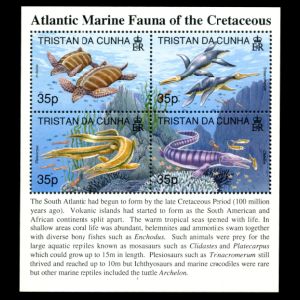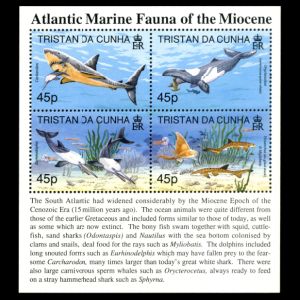the place where Paleontology and Paleoanthropology meets Philately
Tristan da Cunha
Prehistoric animals on stamps of Tristan da Cunha
| << previous country | back to index | next country >> |
Contents:
- Country overview
- Philately of Tristan da Cunha
- Official stamps of Tristan da Cunha related to Paleontology
- References
- Acknowledgements
Tristan da Cunha, colloquially Tristan, is the name of both a remote group of volcanic islands in the south Atlantic Ocean and the main island of that group.
It is the most remote inhabited archipelago in the world, lying 2,000 kilometres from the nearest inhabited land, Saint Helena, and 2,400 kilometres from the nearest continental land, South Africa. It is 3,360 kilometres from South America.
The territory consists of the main island, named Tristan da Cunha, which has a north–south length of 11.27 kilometres and an area of 98 square kilometres, along with the smaller, uninhabited Nightingale Islands and the wildlife reserves of Inaccessible and Gough islands.
As of January 2017, the main island has 262 permanent inhabitants. Tristan da Cunha is part of the British overseas territory of Saint Helena, Ascension and Tristan da Cunha. [R1]
The first stamps of Tristan da Cunha were issued on 1 January 1952 and consisted of twelve stamps of Saint Helena overprinted TRISTAN DA CUNHA. [R2]
Official stamps of Tristan da Cunha related to Paleontology: prehistoric animals
| 10.02.1997 "Atlantic Marine Fauna of the Cretaceous" | 08.07.1998 "Atlantic Marine Fauna of the Miocene" | |
 |
 |
|
References:
Acknowledgements:
Many thanks to Dr. Peter Voice from Department of Geological and Environmental Sciences, Western Michigan University, for reviewing the draft page and his valuable comments.
| << previous country | back to index | next country >> |